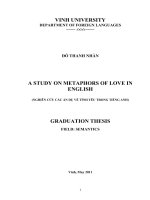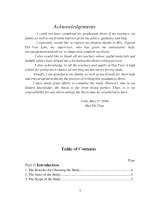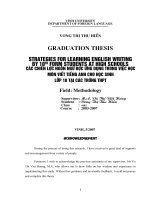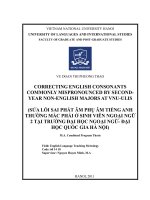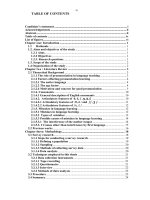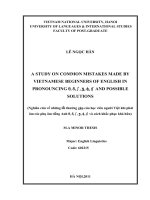correcting english consonants commonly mispronounced by second-year non-english majors at ulis_vnuh = sửa các lỗi sai phát âm phụ âm tiếng anh thường mắc phải ở sinh viên ngoại ngữ 2 tại trường đại học ngoại ngữ
Bạn đang xem bản rút gọn của tài liệu. Xem và tải ngay bản đầy đủ của tài liệu tại đây (936.4 KB, 38 trang )
VIETNAM NATIONAL UNIVERSITY HANOI
UNIVERSITY OF LANGUAGES AND INTERNATIONAL STUDIES
FACULTY OF GRADUATE AND POST-GRADUATE STUDIES
VU DOAN THI PHUONG THAO
CORRECTING ENGLISH CONSONANTS
COMMONLY MISPRONOUNCED BY SECONDYEAR NON-ENGLISH MAJORS AT VNU-ULIS
(SỬA LỖI SAI PHÁT ÂM PHỤ ÂM TIẾNG ANH
THƯỜNG MẮC PHẢI Ở SINH VIÊN NGOẠI NGỮ
2 TẠI TRƯỜNG ĐẠI HỌC NGOẠI NGỮ- ĐẠI
HỌC QUỐC GIA HÀ NỘI)
M.A. Combined Program Thesis
Field: English Language Teaching Metrology
Code: 60 14 10
Supervisor: Nguyen Huyen Minh, M.A
HANOI, 2011
iv
TABLE OF CONTENTS
ACCEPTANCE ..................................................................................................... i
ACKNOWLEDGEMENT ................................................................................... ii
ABSTRACT ......................................................................................................... iii
TABLE OF CONTENTS.................................................................................... iv
PART I. INTRODUCTION ................................................................................ 1
1. Statement of the Problem and the Rationale for the Study .......................... 1
2. Aims of the Study and Research Questions ................................................. 3
3. Scope of the Study ........................................................................................ 4
4. Methodology ................................................................................................. 4
4.1. Design ..................................................................................................... 4
4.2. Participants ............................................................................................. 4
4.3. Data collection instruments .................................................................... 5
4.4. Data collection process ........................................................................... 6
4.5. Data analysis ........................................................................................... 6
5. Significance of the Study .............................................................................. 7
PART 2. DEVELOPMENT ................................................................................ 8
CHAPTER 1. LITERATURE REVIEW ........................................................... 8
1.1. Key Concepts ............................................................................................. 8
1.1.1. English Pronunciation ......................................................................... 8
1.1.2. English Sounds and English Consonants ............................................ 9
1.1.3. Vietnamese Consonants and a Comparison with English Consonant
System 11
1.2. Related Studies ........................................................................................ 13
1.2.1. Problems with Pronouncing English Consonants among Learners of
English as a Second/ Foreign Language ....................................................... 14
1.2.2. Causes of Troubles with English Sounds .......................................... 16
1.2.3. Teaching Techniques......................................................................... 17
CHAPTER 2. METHODOLOGY .................................................................... 24
2.1. Participants................................................................................................. 24
2.2. Data Collection Instruments ...................................................................... 26
2.2.1. Questionnaire .................................................................................... 26
2.2.2. Interviews .......................................................................................... 28
2.2.3. Audio Tapes ...................................................................................... 29
2.2.4. Field Notes ........................................................................................ 29
2.3. Action Plan .............................................................................................. 30
v
2.3.1. Material ............................................................................................. 32
2.3.2. Research plan .................................................................................... 33
CHAPTER 3. RESULTS AND DISCUSSION................................................ 38
3.1. Research Question 1. What are English consonants that are often
mispronounced by non-English majors? .......................................................... 38
3.2. Research Question 2. What are the reasons for the students’ problems of
pronunciation? .................................................................................................. 42
3.2.1. Inadequate exposure to English language ........................................... 42
3.2.2. Inadequate understanding of English sounds ...................................... 43
3.2.3. Influence of mother tongue ................................................................. 44
3.2.4. Influence of first foreign language, i.e. major..................................... 45
3.2.5. Influence of hometown dialects .......................................................... 46
3.2.6. Hesitation to express oneself ............................................................... 47
3.2.7. Other reasons ....................................................................................... 47
3.3. Research Question 3. What are the appropriate techniques employed? ... 51
3.3.1. Phonemic chart, Sound description ................................................... 51
3.3.2. Minimal pairs .................................................................................... 53
3.3.3. Tongue twisters ................................................................................. 54
3.3.4. Comparing students’ speech with the model .................................... 55
3.3.5. Games ................................................................................................ 56
3.3.6. Continuous feedback ......................................................................... 56
3.4. Research Question 4. What are students’ remaining problems in terms of
pronunciation of English consonants after the project? What are possible
reasons? ............................................................................................................. 57
PART III. CONCLUSION ................................................................................ 64
1. Major Findings of the Study ....................................................................... 64
2. Limitations of the Study ............................................................................. 67
3. Suggestions for Further Research ............................................................... 68
4. Recommendations....................................................................................... 69
REFERENCE ..................................................................................................... 71
APPENDICES ...................................................................................................... I
APPENDIX 1 .......................................................................................................I
APPENDIX 2 ..................................................................................................... II
APPENDIX 3 .................................................................................................... IV
APPENDIX 4. .................................................................................................... V
APPENDIX 5 .................................................................................................. VII
1. STATEMENT OF THE PROBLEM AND THE RATIONALE FOR THE
STUDY
The essentiality of teaching and learning the pronunciation of a language
has been proved by many researchers in the world. Setter and Jenkins (2005: 3)
did show the significance of the ability to communicate orally in English. In
other words, it is the key factor to maintain successful oral communication.
Speaking such an international language, effective communicators of English,
especially non-natives need to have an acceptable pronunciation. Therefore,
learning pronunciation is of significance in English study for learners of English
as a foreign language (EFL learners).
In University of Languages and International Studies, Vietnam National
University Hanoi (ULIS-VNUH), English has been taught in all faculties. It is
the major of students of Faculty of English Language Teaching Education. Other
students learn English as their second foreign language. The latter group are
addressed non-English majors in this study. They spend four semesters, from the
fourth to the seventh ones, officially learning English at university. The current
study take non-English majors in their first semester, who are assumed at
elementary level as its subjects.
Despite its significance to the successful learning of English,
pronunciation has not been paid enough attention considering its proportion in
the syllabus of non-English majors at ULIS-VNUH. With 4 or 3 credits (for nonEnglish majors at their first and later terms respectively), those students are
required to cover all four skills. The limitation of time is a challenge to ensure
students’ improvement in pronunciation as it is not a separate skill or subject. As
an important condition to the proficiency of listening and speaking skills (Setter
and Jenkins, 2005: 1), it is believed that pronunciation deserves to receive more
emphasis in the syllabus of non-English majors.
English pronunciation is divided into two main aspects: segmental and
suprasemental. (Roach: 2000, Cruttenden: 2001) The former, also called sounds
or phonemes, forms different segments of words. The modification of one sound
may alter word meaning and consequently influence the meaning of the whole
utterance or discourse. Moreover, a consistent mispronunciation of a range of
phonemes may be the failure to the intelligibility of the speech especially when
both listeners and speakers are not native speakers. (Kelly, 2003: 11)
Considering their basic but undeniable role in teaching and learning English
pronunciation, sounds are in focus of the study.
Despite its importance to enhance learners’ communicative competence,
teaching and learning pronunciation has never been an easy task. It is even “the
most difficult aspect” of second language as stated by Setter and Jenkins. (2005:
1) In regard with such a complex issue, particularly English sounds, a great deal
of research has been done to identify learners’ pronunciation problems and their
reasons. (see Chan & Li, 2000, Nguyen, 2005, Walker, 2000, Kenworthy, 1988)
Research on techniques and activities to facilitate teaching and learning has been
also a field of interest to many researchers. (see Kelly, 2003, To, 2006). Fraser
(2001) suggested not only approach but also specific techniques to teach
pronunciation at various students’ levels while Hancock (2000) provided games
that can be integrated in class to boost students’ understanding and performance.
However, as mentioned previously, little research has been conducted in the field
teaching pronunciation of sounds to non-English majors at ULIS-VNUH. Hence,
there exists a gap which the current research is aimed at bridging.
Aims of the Study and Research Questions
The project will be carried out to reach the following aims. Firstly, the
researcher will attempt to set an overview of the research subjects by detecting
English sounds which are frequently mispronounced by many of the student
participants. This part of the study can enrich the abundant research on ESL
learners’ problems of pronunciation (Chan & Li, 200, Nguyen, 2005, Sang, 2007,
Vu, 2008). Secondly, the factors that caused the problems will be identified, so
that possible techniques to solve the problems will be proposed. Finally,
students’ progress after the project will be assessed. 18 students of Chinese
Faculty will be involved in the research as participants.
The study will, therefore, answer four questions below:
1. What are English consonants that are often mispronounced by nonEnglish majors?
2. What are the reasons for the students’ problems of pronunciation?
3. What are appropriate techniques to correct the problems?
4. What are students’ improvements in terms of pronunciation of
English consonants after the project?
Scope of the Study
As stated above, the research will focus on non-English majors from
different faculties at ULIS-VNUH in their third semester when they begin
learning the language formally at university. Those students at their first English
term are chosen because it is believed that any help given at their beginning
period may have better effect later on. Certain teaching techniques related to
pronunciation training will be studied and discussed to find out the suitable ones.
The treatment will be conducted on the subjects during 10 weeks’ time of the
semester.
Significance of the Study
Once completed, the project will serve as part of continuous research on
the teaching of pronunciation for non-English majors at ULIS - VNUH.
Firstly, the participant students will experience helpful activities and thus
improve their pronunciation of English consonants. Secondly, the results of the
study will be a reference to teachers of English while they work on this part of
pronunciation training.
2. LITERATURE REVIEW
English Pronunciation
According to Daniel Jones (1998:5), pronunciation refers to the way
people pronounce words, which narrows down its scope to word-level. Murphy
(2003 cited in To, et al., 2006) discussed the term in view of hearers’ perception
of the information conveyed through speakers’ pronouncing of not only “words”
but also “phrases and sentences”. In other words, he emphasized on messagetransferring function of pronunciation. However, this is still too general a
definition.
Phoneme
s
Suprasegmenta
l
Vowels
Consonant
s
features
Intonation
Voiced Unvoiced
Single
vowels
Short
Stress
Diphthongs
Long
Word stress
Sentence
stress
(adapted from Kelly, 2000)
Figure 1: Features of pronunciation
English Sounds and English Consonants
English consonants were categorized according to their manner, place of
articulation and voicing, which is illustrated as in table 1 below.
Manner
of
articulati
on
Place of articulation
Bilabi
Labi Dent
Alveol Post-
Palato Palat
Vel
Glott
al
o
ar
alveol
-
al
ar
al
ar
alveol
al
dent
al
Plosive
ar
Affricative
Fricative
Nasal
Lateral
Approxim
ant
+ : voiced
- : unvoiced
(adapted from Cruttenden, 2001)
Table 1: Classification of English consonants
Vietnamese Consonants and a Comparison with English Consonant System
Place of articulation
Manner of articulation Labial
Alveo-
Palata Velar
ar
Aspirated
Alveol
palatal
l
t’
ʈ
Nasal
Stop
Non-
ʐ
Nonaspirated
Fricative
aspirated
Nasal
latteral
Glottal
ʔ
ɲ
Ŋ
ɣ
(adapted from Mai, Vu, & Hoang, 1997)
Table 2: Vietnamese initial consonants
Place of articulation
Manner
of
Bilab
articulation
ial
Alve
Velar
olar
Stop
Nasal
Ŋ
Non-nasal
(adapted from Mai, Vu, & Hoang, 1997)
Table 3. Vietnamese final consonants
There is hardly any restriction of position for a certain English consonant
in one word, meaning the sound can appear at the beginning, in the middle or at
the end of the word . In Vietnamese phonology, however, only 8 consonants
could be in word-final position (table 3), while 22 items form a group called
word-initial position. The two groups share 5 items which are /t/, /k/, /m/, /n/, /ŋ/.
In contrast to the theory, in practice, normally, those with Hanoi dialect do not
produce alveo-palatal sounds /ʈ /, /ʐ /, /ş/, which are tended to be replaced with
-palatal sounds are
produced by people from central region of Vietnam.
Related Studies
Problems with Pronouncing English Consonants among Learners of English
as a Second/ Foreign Language
In his famous book, Better Pronunciation, O’ Conner (1980) presented a 5
categories of pronunciation problems among learners from 6 Western and
Oriental nationalities. One of them is sound substitution with other ones from
English or from learners’ L1 due to the lack of corresponding English sounds in
their mother tongues. As revealed by Dr Helen Fraser (2001, p. 33), speakers of
other languages usually replace English consonants that are unfamiliar with near
ones available in their mother tongues. (also seen in Cruttenden, 2001, Lewis &
are among the
most difficult phonemes for speakers of other languages due to the lack of them
in most languages other than English. (Cruttenden, 2001: 184) He also noticed
that /t/ and /d/ were used as their frequent substitutions (see also Chan & Li,
2000 and Makino, 2007)
/z, d/ and / / were produced instead of andcorrespondingly. In the
same study, it was seen that some Vietnamese learners substituted English
plosive (Nguyen, 2005 and Dao, 2007) Nguyen Thi Quynh Hoa (2007)
proved that 80% of her subjects were found mispronounce // sound. Most of
her informants confessed that this sound and its voiced counterpart were among
their problems. In her article, Dr. Duong (2009) did mentioned 4 pairs of English
confusing consonants, which are Vietnamese
Causes of Troubles with English Sounds
Researchers worldwide and within the country have identified causes
of troubles with English sounds as follows
Mother tongue interference has been studied thoroughly (Kenworthy,
1988, Rivers and Temperly, 1978 & Chan and Li 2000)
Other factors may affect the learning are learners’ age, interest and
motivation they raise on the issue, amount of exposure to English language as
perceived by Kenworthy (1988, p. 4 – 7). To enrich the literature, River and
Temperly (1978) affirmed the importance of learners’ speech habits.
In an action research on the role of continuous feedback in students’
pronunciation improvement Tran Thanh Phuc (2006) reviewed seven factors
that affect the pronunciation of Vietnamese learners. Apart from well-known
causes: native language, learners’ ages, she emphasized the influence of the
amount of exposure to English, students’ own phonetic ability, their attitude to
the learning of the language, motivation and teacher’s role. In attempt to discuss
Vietnamese learners’ pronunciation of English sounds, Dr. Duong Thi Nu (2009)
showed four main reasons that account for their failure in making the truly
English consonants: (1) failure in distinguishing the difference, (2) influence of
the mother tongue, (3) perception of mistakes, (4) inadequate drills and practice.
Teaching Techniques
With “seven modes of chart usage” suggested by Underhill, identifying
and differentiating sounds in isolation require a great deal of two-side interaction
between teachers and learners. This is also of important emphasis in
Communicative Language Teaching approach.
Teachers’ model plays an undeniable role in the learning process of
pronunciation (Lewis and Hill, 1999: 66)
Other significant techniques suggested are Minimal Pairs, drilling,
taping students’ speech to compare with each other as well as with a fixed
model, choral pronunciation, Lip-reading, Classifying words according to
their consonant, varying their criterion of “good” in pronunciation teaching
(Kelly, 2003, Hewings, 2004, Bareither 2007, Lewis and Hill, 1999).
Related Studies in Vietnam
As a compilation from materials of different sources, To et. al. (2006)
suggested a number of techniques of teaching sounds which are minimal pairs,
and pronunciation games employing phonemic alphabet. Those ones have been
suggested in view of Communicative Teaching approach. Vu (2008) proved that
(1) Eliciting and Telling, (2) Minimal pairs, (3) Phonemic chart, (4) Exposure to
English language are four really effective techniques to correct students’
mispronunciation. Those techniques are time-saving, therefore, suit well with the
time limitation in class when pronunciation is integrated in speaking lessons.
3. METHODOLOGY
Design
To identify non-English majors’ problems with English consonants, their
causes, effective techniques for pronunciation teaching, an action research will
be carried out.
Participants
The participants of the current research will consist of 18 non-English
majors at ULIS-VNUH. To be specific, they are second-year students whose
major is Chinese.
Data collection instruments
In order to address three research questions, field notes, audio tapes,
questionnaires and semi-interviews will be used as the data collection methods.
Field notes will employed by the teacher researcher in every session of the
research project to detect students’ errors of English sounds as well as judging
the effectiveness of teaching techniques applied in class.
At the first week of the research project, questionnaires will be conducted
on the students to collect students’ personal information that is useful for
considering their pronunciation ability as well as Moreover, it is used find out
those students’ opinions on the reasons for their mispronunciation.
Semi-structured interviews will be conducted in front of the whole
research group in the third, the ninth and the fifteenth weeks of the semester..
The information will be employed to clarify that collected from questionnaires if
necessary and seek for deeper responses.
Audio tapes will be used as a means of assessing students’ pronunciation
ability through their voice recordings prepared at home. These data will be
collected in weeks 7 and 13 of the semester.
Details about the above research methods will be discussed in the third
chapter, named Methodology.
Data collection process
Data from field notes and journals will be keep during all 10 weeks so that
the state and changes of the class can be well followed. Whereas, those from
questionnaire, audio tapes and interviews will be collected at the specific time
mentioned above.
Data analysis
The data collected will be categorized and serve answering each research
question as follows:
Research question 1: data from teacher’s field notes in the second week
and in the following one will be analyzed to clarify problems of pronunciation
and their causes. Those pieces of information will then be classified into smaller
hierarchies of segmental aspect in English pronunciation.
Research question 2: the analysis of data through interviews and
questionnaires will help find out the causes of students’ pronunciation problems.
Research question 3: the effectiveness of teaching and correcting
techniques will be judged during the whole process. Then the ones which work
well on the student participants will be chosen.
Research question 4. Teachers’ field notes on mini-presentations in the
last week and during the research project as well as the students recordings in
week 13 will be the answer to the last question
4. RESULTS AND CONCLUSION
Results
The following part served as a summary of the main findings fully
presented in the previous chapter of the report.
Firstly, the answer to question number one is the identification of the
pronunciation that participants of the study encountered before taking part in it.
11 out of 24 English consonants were reported as problematic sounds with at
least 5 students having difficulties with. Considered the most seriously mistaken
sounds,and caused troubles to all 18 people of the research
population. Less students had troubles with and with 12 and 10 people
for each sound respectively. Being troublesome to 8 partipants / and /g/,
which were followed by /k/ and /j/ with 7 victims, and /w/ with 6, accounting for
roughly 30% of research participants. With 5 students mispronouncing, /r/ was
considered the least serious sound of 11 ones. The common mistakes with these
sounds fall into the following type: replacing the correct sounds with similar
ones of that language or those of their mother tongue. In general, the sounds in
focus of the project are
Secondly, factors that cause the problems discussed above were also
indentified. Totally, there are 7 of them: (1) Inadequate exposure to English
language, (2)Inadequate understanding of English sounds and English
phonology, (3) Influence of native language, i.e. Vietnamese, (4) Influence of
hometown dialects, (5)Hesitation to express oneself, (6)Time management in
learning phonetics, (7) Fossilized habits
It is noticeable that students’ problems were the result of the impact of
more than one reasons. Among 7 causes, the first three ones were shared by all
of the participants. The others could be seen in the cases of different individuals.
Thirdly, basing on participants’ problems and underlying factors that had
been discovered, the researcher planned the specific teaching schedule with
various techniques employed. After the whole project, techniques that were
proved effective in correcting students mistakes were reviewed and chosen. They
are (1) Phonemic chart, Sound description, (2) Minimal pairs, (3) Tongue
twisters, (4) Comparing students’ speech with the model, (5) Games, (6)
Continuous feedback. Each of them brings about its best effect when used in a
specific way and at specific time of the lesson.
Fourthly, the answer to question 4 clarifies the remaining problems
students still had at the end of the project as well as their reasons. In other words,
research population’s progress had been tracked. Significant changes had been
made to the performance of the students. The number of students with
pronunciation problems of English consonants had reduced considerately. The
highest number of students shared the same problematic sound is 12, compared
with 18 at the beginning of the project. Only 4 consonants caused troubles for at
least 5 participants, i.e. only these four sounds were considered problematic ones
at the end of the project. The difficult sounds at this final stages are
with 5, 5, 9, 12 students having troubles respectively. The
reasons for their mispronunciation were the anxiety in speaking and their
fossilize habits that they refused to change.
Suggestions for Further Research
Later researchers who have the same interest of the research field can
benefit from the current study with recommendations for future research.
In terms of scope, future researchers could explore other field of
pronunciation like initial and final consonants, vowels, stress and intonation.
Students’ problems of these aspects could be identified and then handled with
different techniques, which makes a comprehensive picture of correcting
learners’ pronunciation troubles.
Carried out on non-English majors of other departments, the project could
generate markedly different results which benefits the teaching and learning of
students with various majors. This judgment results from the varied beginning
levels of those students, the relation of the language they learn with English.
Then, specific way of teaching and learning appropriate for each group of
students can lead to better result of the treatment on them.
A lesson that future research could draw from the third limitation of the
current study is the form of pre-test and post-test of the project. A consistent
form of both tests with careful preparation could generate better results which
save time and effort for the researchers to organize the activities as the tests and
to analyze data later.
Action research takes place as cycles, which means that the ending of one
cycle is the beginning of another one. With the result of the current study, a new
action research on the same population could be carried out. A new action plan
to solve the remaining problems of the study would be really practical to
improve students’ pronunciation of English consonants in reality.
Recommendation
Taking the results as well as limitations of the project into consideration,
some of the suggestions could be made in hope of bettering the teaching
pronunciation to students as non-English majors.
Firstly, there has been no fixed pronunciation core book and syllabus for
non-English majors till now, which hinders the unity in and effectiveness of
pronunciation learning of those students. Currently, as a small part of the
syllabus, the question of teaching pronunciation or not is decided by individual
teachers. Thus, there is no certainty that all classes have the content in their
learning, let alone the same amount of learning. In other words, without a fixed
and clear syllabus, students pronunciation ability could not be assured.
Secondly, it could be seen clearly that the limitation of time mainly obstructs the
effectiveness of the teaching and learning. If more time or, in better case,
separate time was given to pronunciation teaching in those students’ syllabus,
their ability would surely be improved. Moreover, with a set time saved for
pronunciation, the teachers could have the freedom from fearing lacking time for
other activities as now they only have 200 minutes for all workload of four skills,
grammar and pronunciation. The fix time allotment would help improve in class
instruction, which means saving students’ time and effort to self-study at home.
REFERENCE
Celce-Murcia, M., Brinton, D. & Goodwin, J. M. (1996) Teaching
pronunciation – A reference for teachers of English to speakers of others
languages (1st ed.) Cambirdge: CUP
Chan, A. Y.W. & Li, D. C.S. (2000) English and Cantonese Phonology in
Contrast: Explaining Cantonese Chinese ESL Learners’ English Pronunciation
Problems, Language, Culture and Curriculum 13 (1) retrieved from the World
Wide
Web
on
January
12,
2008
at
/>Cruttenden, A., (2001) Gimson’s Pronunciation of English, 6th ed., New York:
Oxford University Press Inc.
Duong, T. M. H. (2007) A Study on Pronunciation of Some English Consonants
by Vietnamese Learners, Hanoi
Duong, T. N. (2009) Mistake or Vietnamese English, VNU Journal of Science,
Foreign Languages (25): 41-50
Ferrance, E. (2000) Action Research, Northeast and Islands Regional
Educational Laboratory at Brown University, NY
Fraser, H. (2001) Teaching Pronunciation: A Handbook for Teachers and
Trainers retrieved from the World Wide Web on January 19 2008 at
/>Hancock, M. (2000) Pronunciation Games, 6th ed., Cambridge: Cambridge
University Press
Hancock, M. (2003) English Pronunciation in Use, Cambridge: CUP
Hewings, M. (2004) Pronunciation practice activities: a resource book for
teaching English pronunciation, Cambridge: CUP
Hoang, X. H. & Nguyen, T. T. M. (2006) Research Methodology Reading
Package, Hanoi
Jones, D., (1998), The Pronunciation of English, definite ed., Cambridge:
Cambridge University Press
Kelly, G. (2003) How to Teach Pronunciation. Edinburgh, the UK: Pearson
Education Limited
Kenworthy, J. (1988) Teaching English Pronunciation, London: Longman
Group UK Limited
Lewis, M. & Hill, J. (1992) Practical Techniques for Language Teaching,
England: Commercial Colour Press
Li, J. (2007) Questions to be reconsidered in teaching pronunciation, Sino-US
English Teaching, 4 (9) retrieved from the World Wide Web on November 20,
2007 at www.linguist.org.cn/doc/su200709/su20070906.pdf
Mai, N. C., Vu, D. N. & Hoang, T. P (1997) Co So Ngon Ngu Hoc va Tieng Viet,
Hanoi: Duong sat Publisher
McDonough, J. & McDonough, S. (1997) Research Methods for English
Language Teachers, London: Arnold
McMillan, J. H. & Schumacher, S. (1993) Research in Education a Conceptual
Introduction, 3rd ed., New York: Harper Collins College Publishers
Nguyen, M. P. (2005) Common Pronunciation Problem of 2nd-year students and
strategies to overcomes. A Case Study, Hanoi
Nguyen, T. Q. H. (2007) Vietnamese Learners’ Difficulties When Pronouncing
Some English Sounds, Hanoi
Nunan, D. (1992) Research Methods in Language Learning, pp. 53 – 73 London:
CUP
O’ Connor, J. D. (1980) Better Pronunciation, Cambridge: Cambridge
University Press
Reed, A. J.S. & Bergerman, V. E. (2000) A Guide to Observation, Participation
and Reflection in Classroom, Hong Kong: OUP
River, W. M. & Temperly, M. S. (1978), A Practical Guide to the Teaching of
English as a Second or Foreign Language, the USA: Oxford University Press,
Inc.
Roach, P. (2000) English Phonetics and Phonology (2nd ed.) Cambridge, the UK:
Cambridge University Press
Sang, Y. C. (2007) Effects of Phonetic Similarity and L2 Experience: Production
of English /s/ Wide
Web
, retrieved from the World
on
January
12,
2008
at
/>Setter, J. & Jenkins, J. (2005) State-of-the-Art Review Article: Pronunciation.
Language Teaching, 38. pp. 1-13. Cambridge, : CUP
Stern, H. H. (1996) Issues and Options in Language Teaching (3rd ed.) Oxford:
Oxford University Press
To, T. T. H, Nguyen, T. M. H, Nguyen T. M., Nguyen, H. M. & Luong, Q. T.
(2006) ELT Methodology II, Course Book, vol 1. Hanoi
To, T. T. H, Nguyen, T. M. H, Nguyen T. M., Nguyen, H. M. & Luong, Q. T.
(2006) ELT Methodology I, Course Book. Hanoi
Tran, T. L. (2006) 9 Essential English Pronunciation in the Vietnamese Context
retrieved
from
the
World
Wide
Web
on
January
19
2008
at
/>mese_context.doc
Tran, T. P. (2006) An Action Research on the Use of Continuous Feedback to
Improve the First Year Students’ English Pronunciation at the English
Department, College of Foreign Languages, Vietnam National University, Hanoi,
Hanoi
Tran, T. T. Q. (2006) Techniques to Improve Pronunciation for Students at
Foundation Studies Department, Hanoi University of Foreign Studies, Hanoi
Underhill, A. (1994) Sound Foundations: Learning and Teaching Pronunciation,
Oxford, : Macmillan Publisher Limited
Vu, D. T. P. T. (2008) Techniques to Improve the Pronunciation of English
Sounds for 2nd-Year Students in CFL-VNUH, Hanoi
Walker, R.(2001) Pronunciation for International Intelligibility, Karen’s
Linguistic Issues retrieved from the World Wide Web on January 12 2008 at
/>Wallace, M. J. (1998) Action Research for Language Teachers, Cambridge: CUP
Wisker, G. (2001) The Postgraduate Research Handbook, New York: Palgrave
